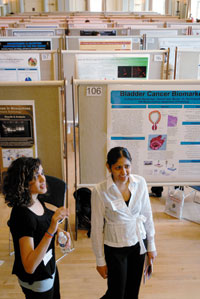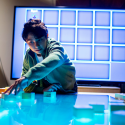Symposium opens world of research opportunity
With 10 years and hundreds of research projects in its history, the Undergraduate Symposium has been instrumental in showcasing undergraduates’ hard work. It’s also opened participants’ eyes to the possibilities of research — and even led some to continue the work they started with the event.

Two students talk during the 2007 Undergraduate Symposium. This year will be the 10th year for the event, and organizers hope to increase the number of participants to 300.
The symposium will celebrate its 10th anniversary this year, and participation has continued to increase, with 215 presenters in 2007 and a goal of more than 300 this year, says Laurie Mayberry, assistant to the provost and symposium coordinator.
“We want to showcase all the work that undergraduates are doing, because there is a richness in their work that not everyone has a chance to see,” says Mayberry. “There’s nothing else like it in size and scope at the university.”
The Undergraduate Symposium began in 1999 in conjunction with the university’s sesquicentennial and is intended to showcase students’ achievements, creativity and research in all areas of the university. Students in the McNair Scholars program were required to make public presentations of their work, so the provost’s office used a $4,500 grant to produce the event — in just two months, with 43 student presenters. The symposium has since become a presentation venue for many undergraduate research programs across campus.
Laura Croal presented in 1999 as a McNair Scholar. She’d conducted research in bacteriology Professor Diana Downs’ lab for two years, researching the ways in which cells’ biochemical pathways communicate to coordinate an efficient metabolism. “At the time, I knew I was interested in pursuing a career in research science and possibly going to graduate school, but was undecided about what particular area of research I wanted to pursue. When I went to work in Professor Downs’ lab, I found a supportive environment where people were enthusiastic about their work and helping me not only develop my scientific skills, but also discover the area of research I was most interested in pursuing,” says Croal.
In preparation, Croal spent up to 20 hours a week in the lab, in addition to her full class schedule. Along the way, she learned to design experiments under Downs’ and a graduate assistant’s tutelage, and she also learned the importance of poster presentations. “As a scientist, you have to present your research regularly, and the more clearly you present it, the better chance you have to get helpful feedback on your experiments. Being able to present your science clearly only comes with experience,” says Croal. The symposium wasn’t intimidating, she says, until she had to present her poster to then-Chancellor David Ward. “That was a bit nerve-wracking!” she says.
Since earning her bachelor’s degree in bacteriology from UW–Madison in 1999, Croal has gone on to a Ph.D. in biology from the California Institute of Technology, and she now is a National Science Foundation postdoctoral fellow at the Massachusetts Institute of Technology (MIT). She hopes to remain in academia. “I enjoy teaching, and I hope to help undergraduates find out if science or research is for them,” she adds.
The symposium is open to undergraduates doing all types of creative work. Anyone who wants to participate must follow a simple application process, submitting abstracts of their work developed with the help of a mentor or sponsor. Because oral and poster presentations are a key component of the symposium, the Writing Center has developed materials and workshops to help students get comfortable with the process. Mentors also play an important role in encouraging students’ participation.
Lauren Silberman participated in the 2004 symposium after joining the Undergraduate Research Scholars program. “The class and my mentor, Kurt Squire [an assistant professor in the Department of Curriculum and Instruction], helped me learn about different research styles and prepared me for the presentations,” says Silberman.
Silberman’s project, “College Athletes’ Use of Sport Video Games,” examined athletes’ use of video games as learning tools. She conducted comprehensive interviews with four male tennis players. “I was interested in why they played virtual tennis between their physical tennis play,” she says. “The idea that video games can be used for learning purposes isn’t novel. The military uses commercial games for training. Sport video games are another example of a rich learning environment.
“When you think of a tennis video game, you not only have a virtual coach that tells you the score after every point (auditory learning), but you also see the score on the screen (visual). This helps many people learn the complicated ‘love’ scoring method used in tennis,” Silberman adds.
Squire’s help as mentor made a difference, Silberman says. “He made the experience really interesting for me. He was very helpful and involved, from the initial project goals until the final presentation at the Undergraduate Symposium,” she says. “The entire project would have been really overwhelming without his support; he even let me enroll in his graduate class to help me learn more about the field.”
And Silberman has continued work on the project after leaving UW–Madison; she’s now working on a master’s degree in MIT’s comparative media studies department and may pursue a Ph.D. “Recently I had the opportunity to interview some members of the Boston Red Sox about their virtual game play,” she says. “Without the Undergraduate Scholars Program and the Undergraduate Symposium, it would be hard to imagine that I would be where I am today.”
Recent participants continue to see the symposium as an opportunity to develop career possibilities. Sarah Gagnon, a senior in the design studies department, was a 2007 presenter. Her project, called “Knit Two Together,” was a two-semester after-school program for 15–20 adolescent girls in partnership with the Atwood Girl Neighborhood Power organization. The goal was to teach girls how to knit and crochet in a relaxed environment, iating a “knitting circle.”
Gagnon and her research partner, Kaleen Enke, who graduated last May, identified three goals for the project, including a public exhibition of the girls’ work, but found that they had to scale back their plans.
Still, Gagnon considers the project a success, even though her expectations changed. “We learned about how to be effective with them in designing curriculum in the future, as well as how to be firm, yet fun,” she says.
“This project introduced me to working with local community centers and related groups. I feel like a door is open for my continued involvement,” Gagnon, who graduates in May, adds. She hopes to develop a design cooperative in Madison comted to promoting the values she worked out of for the project.
“Working with lower-income or ‘at-risk’ girls was great for me because I did not want to help them or teach them something, but to get to know them and enjoy each other’s company,” Gagnon says. “For me, this was a wonderful way to build relationships and expand my day-to-day experience and to spend more time with people who are different from me culturally and in age.”
Proposals for the 2008 Undergraduate Symposium will be accepted until Thursday, Feb. 28. Any UW–Madison undergraduate may participate in the event, to be held on Wednesday, April 16, in the Memorial Union. For more details, visit Undergraduate Symposium.
Tags: events, learning, research, student resources


